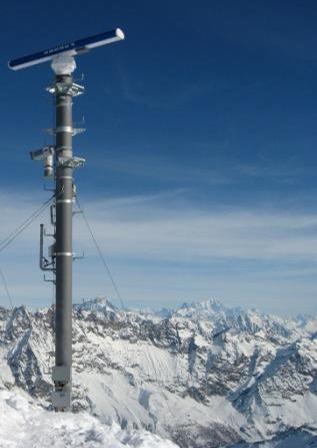Rainfall Analysis
Precipitation is a hydrological process that is highly variable in space and time due to the complex interactions between atmospheric circulation, water vapour fluxes and surface topography. Research on precipitation was a core long-term interest of the Chair exploring rainfall data and sensing methods and developing stochastic rainfall simulators. As a centre of rainfall research the Chair hosts the regular international workshop on urban rainfall UrbanRain.
Rainfall measurement and relations to air temperature

Rainfall measurement is complicated, especially in mountainous areas. A major research challenge is to combine information from ground weather stations with remote sensing by satellite and weather radar. In this research we have explored the use of a short-range X-band radar in an Alpine setting between August 2007 and October 2011 on the summit of the Kl. Matterhorn at 3883 m. At the time this was the highest fixed weather radar installation in the world. We also used long records of station data (Switzerland) and radar data (Israel) to explore observation-based relations of rainfall intensity to air temperature to support the understanding of storm types and their possible shifts, and the rain intensities they produce, for example for climate change impact studies.
Projects:
Klein Matterhorn X-band Radar
Rain Intensity Relations to Air Temperature
Rainfall simulators and stochastic weather generators

Rainfall is an intermittent process with a space-time structure than can be statistically described and modelled with stochastic simulators for use in hydrological impact studies.The Chair was a centre for the development of such simulators since early work by Paolo Burlando on the Neyman-Scott and Bartlett-Lewis external page rectangular pulse models for rainfall and by Peter Molnar on the external page discrete random cascade models for rainfall disaggregation. The Chair has continued in the development of space-time stochastic rainfall simulators such as the model external page STREAP (project SCALP). This model became part of the new 2-dimensional weather generator AWE-GEN-2D developed in the Chair, which combines physical and stochastic approaches to simulate other key climate variables like cloud cover, near-surface air temperature, solar radiation, vapor pressure, atmospheric pressure and near-surface wind, at high resolutions in time (min) and space (m-km), and is designed for use in climate change impact studies.
Projects:
SCALP
AWE-GEN-2D